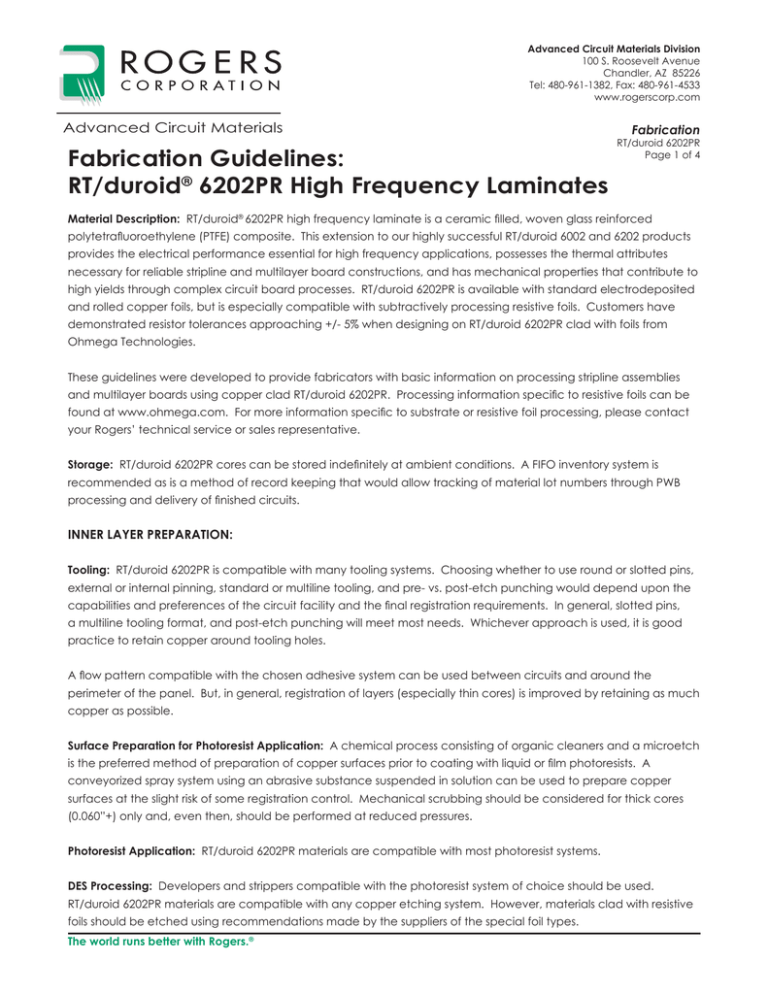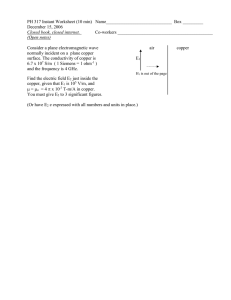
Advanced Circuit Materials Division
100 S. Roosevelt Avenue
Chandler, AZ 85226
Tel: 480-961-1382, Fax: 480-961-4533
www.rogerscorp.com
Advanced Circuit Materials
Fabrication Guidelines:
RT/duroid® 6202PR High Frequency Laminates
Fabrication
RT/duroid 6202PR
Page 1 of 4
Material Description: RT/duroid® 6202PR high frequency laminate is a ceramic filled, woven glass reinforced
polytetrafluoroethylene (PTFE) composite. This extension to our highly successful RT/duroid 6002 and 6202 products
provides the electrical performance essential for high frequency applications, possesses the thermal attributes
necessary for reliable stripline and multilayer board constructions, and has mechanical properties that contribute to
high yields through complex circuit board processes. RT/duroid 6202PR is available with standard electrodeposited
and rolled copper foils, but is especially compatible with subtractively processing resistive foils. Customers have
demonstrated resistor tolerances approaching +/- 5% when designing on RT/duroid 6202PR clad with foils from
Ohmega Technologies.
These guidelines were developed to provide fabricators with basic information on processing stripline assemblies
and multilayer boards using copper clad RT/duroid 6202PR. Processing information specific to resistive foils can be
found at www.ohmega.com. For more information specific to substrate or resistive foil processing, please contact
your Rogers’ technical service or sales representative.
Storage: RT/duroid 6202PR cores can be stored indefinitely at ambient conditions. A FIFO inventory system is
recommended as is a method of record keeping that would allow tracking of material lot numbers through PWB
processing and delivery of finished circuits.
INNER LAYER PREPARATION:
Tooling: RT/duroid 6202PR is compatible with many tooling systems. Choosing whether to use round or slotted pins,
external or internal pinning, standard or multiline tooling, and pre- vs. post-etch punching would depend upon the
capabilities and preferences of the circuit facility and the final registration requirements. In general, slotted pins,
a multiline tooling format, and post-etch punching will meet most needs. Whichever approach is used, it is good
practice to retain copper around tooling holes.
A flow pattern compatible with the chosen adhesive system can be used between circuits and around the
perimeter of the panel. But, in general, registration of layers (especially thin cores) is improved by retaining as much
copper as possible.
Surface Preparation for Photoresist Application: A chemical process consisting of organic cleaners and a microetch
is the preferred method of preparation of copper surfaces prior to coating with liquid or film photoresists. A
conveyorized spray system using an abrasive substance suspended in solution can be used to prepare copper
surfaces at the slight risk of some registration control. Mechanical scrubbing should be considered for thick cores
(0.060”+) only and, even then, should be performed at reduced pressures.
Photoresist Application: RT/duroid 6202PR materials are compatible with most photoresist systems.
DES Processing: Developers and strippers compatible with the photoresist system of choice should be used.
RT/duroid 6202PR materials are compatible with any copper etching system. However, materials clad with resistive
foils should be etched using recommendations made by the suppliers of the special foil types.
The world runs better with Rogers.®
Page 2 of 4
Oxide Treatment: RT/duroid 6202PR is compatible with most oxide and oxide alternative processes. It is best to use the
process recommended by the supplier of the adhesive system chosen to bond together the multilayer board, as long as
that process is compatible with recommendations made by suppliers of the resistive foils.
BONDING:
Final Preparation: Special pretreatments of etched surfaces using sodium or plasma processes shouldn’t be necessary
provided care was taken to protect the substrate surface after copper etch. Inner-layers should be baked at 120-150°C for
30-120 minutes to ensure removal of volatile substances prior to MLB bonding. Guidelines for the oxide treatment and the
resistive foils (if used) should be referenced for optimum bake conditions.
Multilayer Adhesive System: RT/duroid 6202PR materials are compatible with a broad range of thermosetting (FR-4,
RO4400™, etc.) and thermoplastic (3001 bonding film, FEP, ULTRALAM® 3908, PFA, PTFE, etc.) adhesive systems. Many
factors, such as electrical performance, flow characteristics, ease of processing, and bond temperature requirements are
considered when making the best overall choice. Rogers’ Technical Service Engineers (TSE’s) understand the trade-offs
and, if asked, will help in the selection process.
Multilayer Bond Cycle: The press cycle is determined by the requirements of the chosen adhesive system. Cooling under
pressure is required when using thermoplastic (meltable) films.
PTH & OUTER LAYER PROCESSING
Drilling: Multilayers are most commonly drilled in stacks of one. Phenolic composite boards are recommended for entry
(0.010” to 0.030” thick) and exit (>0.060”) layers. Sheeted aluminum and metal coated phenolic boards can also be used
as entry layers.
New carbide drills are highly recommended. Standard or undercut styles can be used. Recommended chip loads (0.001”
to 0.003” per revolution) and surface speeds (150 to 300 SFM) vary with tool diameter with slower infeeds and speeds being
associated with finer diameter drills. Retract rate when drilling multilayer boards should be between 300 and 500 IPM.
Below is a quick reference table that provides recommended parameters for commonly used drill diameters.
Tool life should be based upon inspection of cross-sectioned holes. The “twelve inch rule,” which suggests changing a tool
after drilling 12” of substrate, is a good place to start. For example, initial hit count when drilling a 0.060” thick board would
be 12”/0.060” = 200 holes.
Tool Size
Spindle Speed
Indeed
Retract
(in)
(mm)
(RPM)
(IPM)
(m/min)
(IPM)
(m/min)
0.0079
0.20
72500
72.5
1.8
300
7.6
0.0098
0.25
68200
88.7
2.3
300
7.6
0.0138
0.35
55400
83.1
2,1
300
7.6
0.0197
0.50
48200
96.4
2.4
400
10.2
0.0256
0.65
37200
74.2
1.9
400
10.2
0.0295
0.75
32200
64.4
1.6
400
10.2
0.0394
1.00
24100
48.2
1.2
400
10.2
0.0492
1,25
20000
40.0
1.0
400
10.2
0.0625
1,59
20000
40.0
1.0
400
10.2
0.1250
3.18
20000
40.0
1.0
400
10.2
Page 3 of 4
Deburring: The use of flat, rigid entry materials, conservative drilling parameters, and limited hit counts with new drills should
minimize the risk of copper burring. When drilled properly, cores should be ready for subsequent processing. If debur is
necessary (and slight), a chemical microetch process is preferred. If mechanical processing is required, a hand pumice
scrub is preferred over a suspended abrasive spray system which, in turn, is preferred over a conveyorized mechanical
debur or planarization process.
Hole Preparation: Loosely deposited debris in the holes can be removed using a vapor or hydro-honing process. These
processes involve directing water suspended abrasive particles through drilled holes. The soft laminates must be properly
supported through these processes.
Broken glass bundles can be removed using the process described above or dissolved using a glass etch process that is
standard to most FR4 material chemical desmear processes.
Depending upon the adhesive system used (FR4, for example), a chemical or plasma desmear process may be required.
These desmear processes will have little effect on the RT/duroid 6202PR materials and should be done prior to activation
of the PTFE surface. The chemical process appropriate for desmear of the adhesive system can be used. CF4/O2 plasma
can also be used. A dual plasma cycle to accomplish desmear of an adhesive system and activation of the PTFE surface
is made possible by adding the desmear cycle outlined below to the front end of the treatment cycle described in the
treatment portion of this section.
Frequency 40KHz
Voltage:
500-600V
Power:
4000-5000 Watts
Preheat to 60°C using:
Gases: 90% O2M 10% N2
Pressure: 250 mTORR
Desmear using:
Gases: 75% O2, 15% CF4, 10%N2
Pressure: 250mTORR
Time: 10-30 minutes
Drilled holes in PTFE-based laminates must be treated prior to the deposition of a conductive seed layer (e.g., electroless
copper or direct metallization). Not performing a surface activation treatment will most likely result in poor metal adhesion
or plated voids. Two common pre-treatments for PTFE materials are sodium treatment and plasma treatment. Either can be
used for treating RT/duroid 6202PR materials.
Sodium treatment products and recommended application procedures are available from:
Poly-Etch
Fluoro-etch
Matheson Gas Products
61 Grove Street
Gloucester, MA 01903
978-283-6177
Acton Associates Inc.
100 Thompson Street
Pittston, PA 18640
570-654-0612
Page 4 of 4
A recommended plasma cycle for treating PTFE materials is:
Gases: 0/30 or 80/20 H2/N2, NH3, N2, or He
Pressure: 00 mTORR pumpdown
50 mTORR operating
Power: 4000 Watts
Frequency: 40 KHz
Voltage: 500-600V
Cycle time: 10-30 minutes
Metallization: RT/duroid 6202PR materials are compatible with traditional electroless copper and direct deposit metallization
processes. Cores should be baked (30-90 minutes @ 120-150oC) prior to metal deposition unless plasma, which also serves
as a vacuum bake, was used to prepare the hole walls for plating. A flash plate build-up of 0.0001” to 0.0003” (0.0025mm0.0076mm) of copper is recommended to better support hole walls through preparation for outer-layer processing.
PTH Plating & Outer-Layer Imaging: Standard equipment and chemical processes are used to plate, image, and etch
circuit patterns onto RT/duroid 6202PR materials. Care should be taken to preserve the post-etch dielectric surface. The
topography that remains after copper removal promotes improved adhesion to soldermasks. Materials should be rinsed
and baked prior to soldermask application. Rinsing in warm or hot water for 20-30 minutes followed by 60 minutes at 125oC
should be sufficient, especially if the bake is done under vacuum.
Final Surfaces: RT/duroid 6202PR materials are compatible with most LPI soldermasks. Epoxy soldermasks are preferred if
the application requires selective silk screening. Most final metal surfaces (ENIG, Sn, Ag, Ni/Au, OSP, etc.) can be applied
without special issue or consideration. A bake, as was described prior to soldermask application, should be performed prior
to HASL or reflow exposures.
Final Circuitization: Individual circuits can be routed, punched, or lased depending upon preference, tolerances, and
edge quality requirements. Parameters for routing are provided below:
Chip Load: 0.00125” to 0.00250”/rev
32mm – 64 mm/rev
Speed: 200-300 sfm
61-92 m/min
Peripheries: Conventional cut
Internal cut-outs climb cut
Tool type: Carbide double fluted spiral-up endmill
Exit/Entry: Phenolic or composite board
Tool life: 20-30 linear feet
6-9 meters
Pre-rout vacuum channels in backer board.
Double pass (opposite directions) when cleanest edge quality is required.
The information in this data sheet is intended to assist you in designing with Rogers’ circuit materials. It is not intended to and does not
create any warranties express or implied, including any warranty of merchantability or fitness for a particular purpose or that the results
shown on this data sheet will be achieved by a user for a particular purpose. The user should determine the suitability of Rogers’ circuit
materials for each application.
These commodities, technology and software are exported from the United States in accordance with the Export Administration regulations.
Diversion contrary to U.S. law prohibited.
The world runs better with Rogers. and the Rogers’ Logo are licensed trademarks of Rogers Corporation
ULTRALAM, RO4400 and RT/duroid are licensed trademarks of Rogers Corporation.
© 2013 Rogers Corporation, Printed in U.S.A. All rights reserved.
Revised 1022 020613 Publication #92-425





